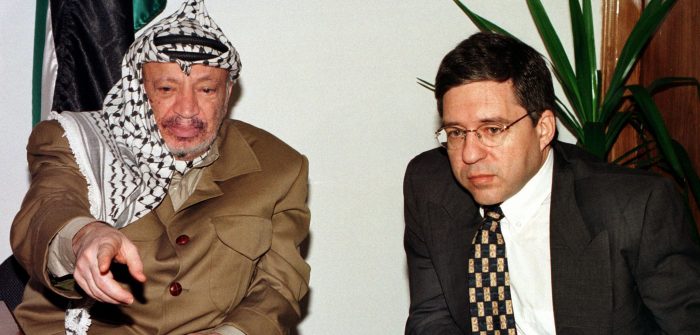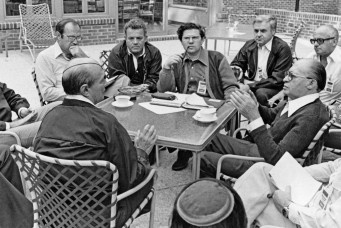Oslo and Camp David: One and the Same?
What we have learned from the Oslo Accords needs to influence a future agreement so that a lasting Camp David-like peace can be reached between Israelis and Palestinians

Palestinian President Yasser Arafat in a meeting with former Israeli cabinet minister Yossi Beilin in the West Bank town of Jericho, April 27, 1997. Rula Halawani/Reuters
During the last quarter of a century, much has been attributed to the “Oslo concept”—the idea that Israelis and Palestinians should negotiate an interim agreement rather than go directly to a permanent solution—either in an attempt to explain why the Oslo process has not been conducive to peace, or to argue that such an incremental process is the only way to proceed in the future.
However, that “concept” was not part of the philosophy that guided my colleagues and me to establish back-channel negotiations with the Palestine Liberation Organization in the summer of 1992—what would eventually become the Oslo process. My belief at the time was that the obstacles preventing progress in negotiations on Palestinian self-rule were totally artificial, and could be surmounted through direct talks, rather than the official negotiations taking place at the time between the Israelis and a joint Jordanian–Palestinian delegation in Washington. The opportunity hinged only on the Labor Party winning the June 1992 election.
Birth of the Interim Agreement
To find the source of this idea for an interim agreement, we must return to the Camp David accords. In the discussions between Anwar Sadat and Israel’s then newly-elected Prime Minister Menachem Begin, it became clear to the latter that there was no chance of reaching a bilateral peace treaty with Egypt, without a detailed reference to the Palestinian issue. Sadat spoke clearly about the need to establish a Palestinian state in the West Bank and Gaza, and referred to it in his speech in the Israeli Knesset, while Begin was committed ideologically to building more settlements in the Occupied Territories, and was firmly opposed to any idea of dividing the land to the west of the Jordan River.
Yet, Begin also wanted to sign a peace treaty with Egypt, and understood that he had to, somehow, square the circle. With this in mind, he presented his plan for autonomy in a plenary session of the Knesset. His idea was to render full human rights to the Palestinians, while preventing them from fulfilling their right to self-determination. Building on an idea from his mentor, Ze’ev Jabotinsky, he suggested self-rule for the Palestinians, without any reference to territorial boundaries, and added that each Palestinian would choose between an Israeli citizenship and a Jordanian one. Begin’s proposal referred to a permanent solution, which could be reconsidered by the parties after five years, but he emphasized that he did not see his concept as an interim one.
The criticism of Begin’s plan was very harsh in Israel and on the Palestinian side, because it did not meet the Palestinian need for national expression, even as it endangered the Jewish majority with something closer to a one-state solution.
Begin himself launched an international trip, presented his “autonomy plan” to a number of world leaders, and after returning home he bragged that all the leaders who had seen the plan praised it. President Sadat was not one of them. He clarified to Begin that there was no chance that he could agree to a non-state solution, and that was one of the reasons for the long crisis in the talks between the two parties until September 1978. Eventually, a compromise was found with the signing of the “Framework for Peace in the Middle East,” which retained the stipulations on Palestinian self-rule, with no mention of optional citizenships. It was agreed that the five-year period would be an interim one, and that by the beginning of the fourth year, the two parties would begin negotiating a permanent agreement.
Apparently, Begin’s readiness to agree to a process which could have been a channel to a Palestinian state stemmed from the fact that there was no reference, in the Camp David Accords, to what would happen if the parties could not achieve an agreement at the end of the five-year period. I can imagine that Begin, with his legal mind, said to himself that the Israeli side would never agree to a Palestinian state, and since there would be no agreement on the permanent solution, the interim arrangement would prevail for infinity.
The Arab World didn’t adopt the Camp David Accords, and Sadat was too optimistic to believe otherwise. I remember asking him, in July 1978, which Arab country would join Egypt first, and he didn’t hesitate before answering: “Saudi Arabia!” I remember long discussions with Dr. Boutros Boutros-Ghali— nominated by Sadat as acting foreign minister—with the title of minister of state—in which he used to tell me how humiliated he had been when he tried, unsuccessfully, to convince the Arab leaders to follow Egypt’s lead and support the accords, until Egypt was ousted from the Arab League.
The situation was quite pathetic: Egypt, the leader of the Arab World, lost its sphere of influence for the coming years. Begin nominated his minister of interior to lead the Israeli delegation to the negotiation table on the issue of Palestinian self-rule. The Palestinians themselves boycotted the talks, so that the Egyptians were the ones negotiating with Israel on the Palestinians’ future in what would be referred to as the “Autonomy Talks.” The talks were a farce, and led nowhere, mainly because Begin did not want them to go anywhere, and saw them, primarily, as an olive branch which was needed for Sadat to implement the bilateral agreement with Israel. The more moderate ministers in Begin’s cabinet—Defense Minister Ezer Weizman and Foreign Minister Moshe Dayan—resigned, and blamed Begin for leading futile talks. Eventually, these talks stopped and were not renewed after the assassination of President Sadat. United States Secretary of State George Shultz tried, unsuccessfully, to renew them in 1982.
When Secretary James Baker initiated the Madrid Peace Conference of October 1991, and met reluctant invitees, he managed to convince all of them (Syrians, Jordanians, “non-Palestinian Liberation Organization [PLO]” Palestinians, Lebanese, and Israelis) to attend by promising that the conference would only cover what was laid out in the original, detailed invitation—with no surprises. The invitation reiterated the Camp David formula for the Palestinian issue— an interim period of five years and no mention of what would happen if a permanent agreement was not reached in that time. That convinced the hawkish Israeli Prime Minister, Yitzhak Shamir, to participate in the conference. Shamir later admitted that he had intended to drag the talks out for ten years.
This ridiculous situation, in which the “non-PLO” Palestinians agreed to be part of a joint delegation with the Jordanians, but after every round of talks in Washington would travel to Tunisia to get directives from PLO Chairman Yasser Arafat, led nowhere. The negotiations would have ended exactly like the demise of the Autonomy Talks, had there been no political upheaval in Israel.
The Moment for a Back Channel
Terje Rød-Larsen, the head of the Norwegian think tank Fafo, came to meet me in Tel Aviv in June 1992 and suggested we use his organization’s facilities for back-channel talks with the Palestinians, provided the Labor Party won the June elections that year, and that my role in the new administration would be relevant to the peace process. I told him that we needed to solve a number of issues on the agenda of the Washington talks, and that without a back channel it would be difficult to proceed. In a few months we began the Oslo Process with the PLO representatives, who had a mandate to overrule their compatriots in Washington. When we achieved the first agreed-upon paper with the Palestinians in February 1993, I informed Shimon Peres, the foreign minister whom I deputized, about the secret channel; he updated Prime Minister Yitzhak Rabin about it and we got the green light to continue. At that moment “Oslo” became an official channel from the Israeli point of view.
My own philosophy opposed the interim solution. I was sure that it was invented, originally, so that a permanent agreement would never be reached. I also thought that a permanent two-state solution should be negotiated immediately, rather than waiting five years for another round of elections in Israel, which would allow extremists from both sides to thwart our efforts.
In a long meeting with Prime Minister Rabin, I suggested he take the bull by the horns, and immediately begin secret talks with the PLO representatives in Oslo for a permanent agreement, rather than continuing on the basis of Begin’s five-year concept for Palestinian self-rule. Rabin thought for a minute and raised two reasons for not doing it. The first was that if we tried to negotiate the permanent solution and failed it would be difficult, and maybe impossible to renew the talks on the interim option. The second was more political; he believed (wrongly) that if we followed in the footsteps of Begin, we would gain legitimacy in the eyes of the general public, which would be needed. I failed to convince him otherwise.
I must admit that not only the Israeli side was hesitant to negotiate directly on a permanent agreement, the chief negotiator on the Palestinian side, Ahmed Qurei (“Abu Ala”), believed that the Palestinians were not ready to begin such talks. However, the idea of gradualness was not the brainchild of the Oslo talks, nor even the Madrid invitation; it was the Israeli–Egyptian compromise of 1978, which was inherited by later peacemakers. Ultimately, the Oslo agreement achieved two important successes: first, the mutual recognition between Israel and the PLO, and second, the specific reference to territory, managed by Palestinian self-rule, rather than Begin’s bizarre idea to establish a non-territorial autonomy.
The conspiracy theories which have emerged in years since—that the Oslo process was launched to allow further settlements, or prevent the Palestinians from having their own state, confine them to small parts of the West Bank, and separate the West Bank from the Gaza Strip—are sinister, and totally wrong. The problem with conspiracy theories is that they take an existent situation and falsely attribute it to premeditated intentions.
It is true that the Israeli side, under Rabin, did not have a coherent vision of a permanent solution. However, most of us believed in the two-state solution on the basis of the 1967 borders, with East Jerusalem as the Palestinian capital, and a solution for the Palestinian refugees based on financial compensation and a token number of Palestinians who would be allowed to live in Israel.
The real story is that both sides were surprised by their own extremists, and by their cruel behavior. The massacre in the Cave of the Patriarchs in Hebron by an Israeli physician in his army officer uniform, the retaliation by Hamas suicide bombers, and the assassination of Rabin were totally unexpected and poisoned the atmosphere.
The right wing in Israel has been in power most of the time since the 1996 elections and has been using the Oslo road toward a Palestinian state exactly as Begin wanted it. The division on the Palestinian side, between Fatah and Hamas, has been devastating for the Palestinian cause, and does not make it easier to proceed with a peace process. Political developments in our region vindicate the thinking that it was a huge mistake not to negotiate the permanent agreement in 1993. Oslo changed the whole picture of Palestinian–Israeli relations. It brought home many Palestinians, created Palestinian governmental institutions, and legitimized the Palestinian national leadership. Yet, other than the mutual recognition achieved between the PLO and Israel, there is no “Oslo legacy” to be followed. If there is a legacy, it is mainly not to repeat the attempt to go for an interim agreement, but rather to go for a fully detailed permanent agreement, and to implement it—at least major parts of it—as soon as possible.
It is a very clear fact: in Oslo, and especially since its implementation, an Israeli delegation committed to peace with the Palestinians used a tool which had been created fifteen years earlier to perpetuate a Palestinian “self-rule” situation. The suspicions of the Palestinians were confirmed when Benjamin Netanyahu came to power, and, rather than canceling the Oslo Agreement, decided to convert it into an informal, permanent deal.
Putting Our Collective Wisdom to Work
Once there is, again, an Israeli government which understands that real peace with the Palestinians is a vital Israeli national interest, and when there is an Israeli prime minister who understands that such an endeavor may cost him his life—a fate that befell both President Sadat and Prime Minister Rabin—only then will it be possible to use the wealth of experience which has been gathered since the beginning of our secret channel in Norway, more than a quarter of a century ago.
When we began our exciting trajectory with the PLO in 1992, neither side had any idea what could solve the outstanding problems on the joint agenda (refugees, borders, Jerusalem, settlements, and security). Today we know: The “Beilin–Abu Mazen” informal paper of 1995, the “Clinton Parameters” of 2000 (which, officially, were taken off the table once Clinton ended his term, but, practically, have remained there since), the informal joint “Geneva Initiative” (2003) with its five hundred pages of annexes, which deal with the details of implementation, and the unfinished official jobs of the Camp David summit (2000), the Taba talks (2001), the Annapolis talks (2007–2008), and the Kerry talks (2013–14)—all of them are significant bricks in the future house of peace.
Today we, Israelis and Palestinians, know each other much better. We know each other’s vital needs, and we will not have to begin from scratch, when the opportunity for peace arrives. I believe that it was possible to establish peace many years ago, and to prevent the needless death toll, but I cannot say that all these years were wasted. At the time of writing this in October 2018, the Trump administration’s peace plan has not been announced yet, and I do not know how serious it will be. I only know that the Palestinians should not dismiss it without reading it. There are forces in this world who like to portray them as the eternal naysayers, and the Palestinians should not play into their hands. This year we will have elections for the Knesset, and a political upheaval may bring dramatic changes.
The next Israeli prime minister should see President Mahmoud Abbas as a partner and agree to negotiate with him a permanent agreement on the basis of the 1967 borders (with mutual modifications). Abbas is not a very strong president, and not a young one. The Palestinian polity is split between Fatah and Hamas, which is a disaster for the Palestinians and for those who want to make peace with them, but neither the Israeli nor Palestinian peace camps should give Hamas veto power over the bilateral peace talks. Israel should sign with Abbas a full peace agreement, and implement it first, in the West Bank. Once there is an authority in Gaza that is ready to join the peace treaty, Gaza will become part of the Palestinian state, and a “safe passage” will be established between the strip and the West Bank. It is vital that the Arab countries, Egypt first and foremost, accompany the future peace negotiations, assist the parties throughout, and implement full normalization of relations with Israel once a deal is signed.
If Hamas sticks to its guns, if it is not ready to recognize Israel and to be part of the future peace negotiations, it will be important that the Arab World does not allow it to be the spoiler of peace efforts, supporting instead a long armistice.
One idea which has never been referred to in the negotiations is the possibility of creating a joint framework for the two states. I believe that the establishment of a “Holy Land Confederation” between two independent and sovereign states will make it easier to achieve the two-state solution (even if it is agreed in advance that the Palestinian state will be established first, and the confederation created later on).
Several considerations support this proposal. The entire area, west of the Jordan River, is so small, and any border will be artificial. There is a need for coordination in zoning and planning, for working together on connected infrastructures, fighting agricultural diseases, maintaining a clean environment, using natural resources sustainably, coordinating security activities, and allowing each other to live under their sovereignties as permanent residents, while keeping the citizenship of their origin states. Even the delicate issue of sovereignty in the old city in Jerusalem may find an original solution, if it is agreed to have some joint authorities working under a future confederation. Looking back at the Oslo process, I can say the following: the informal process that paved the way for an official one enabled Israel to negotiate, for leadership, and to strike a deal. The deal referred to a geographical area, rather than to Begin’s original idea of “personal autonomy.” It was a significant development which did not go far enough and did not exploit that rare moment in history to go immediately for a permanent solution. All of us are paying the price for not being courageous enough in 1993.
Yossi Beilin is former deputy foreign minister, justice minister, and minister of religious affairs in the Israeli Labor Party. In 1995, he formulated the “Beilin–Abu Mazen understandings” that became a basis for future peace initiatives. Between 2004 and 2008, he joined and headed the Meretz-Yachad Party. Beilin initiated both the Oslo process and the Geneva Initiative, launched on December 3, 2003, for which he served as chief negotiator. He also negotiated the Cairo–Taba PLO–Israeli talks in 2001. He is the author of Touching Peace: From the Oslo Accord to a Final Agreement; His Brother’s Keeper: Israel and Diaspora Jewry in the Twenty-first Century; and Israel: A Concise Political History.
Subscribe to Our Newsletter





